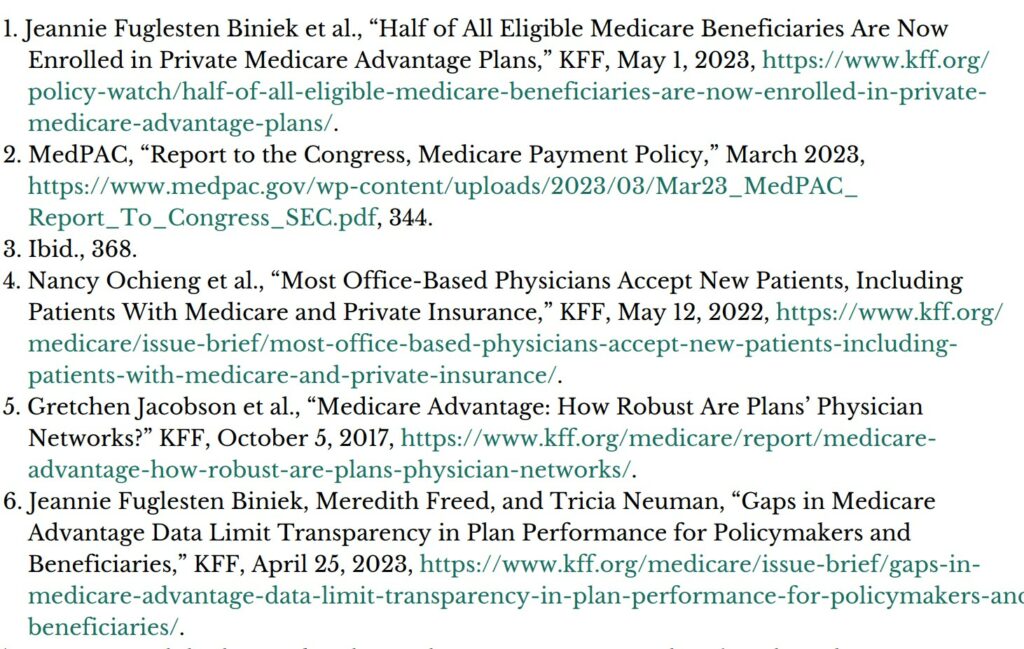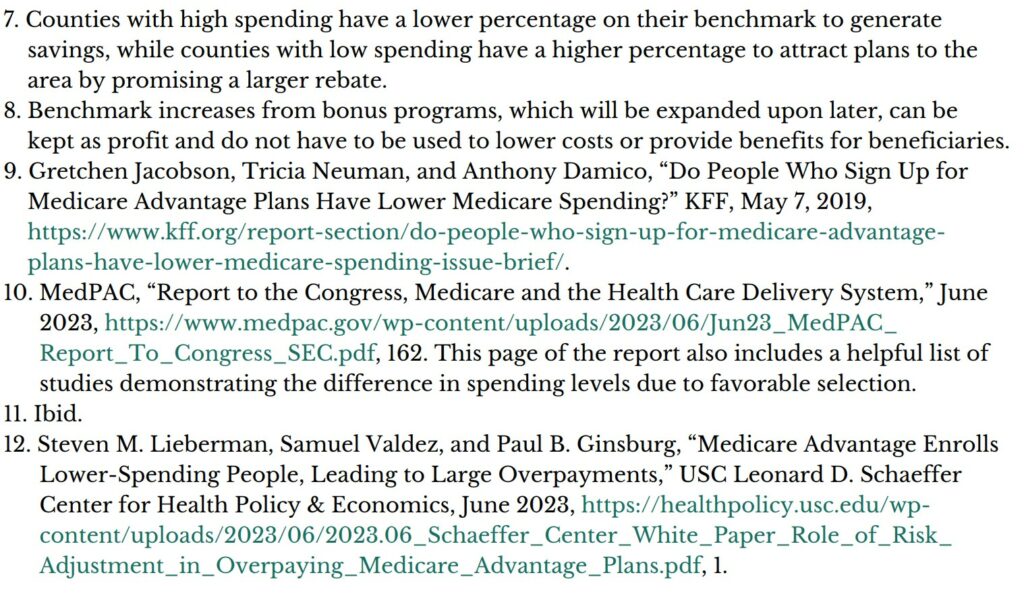In “2022 Overpayment to Medicare Advantage? Somewhere between 22% and 35%,” Angry Bear, we featured Kip Sullivan’s article, “Medicare Advantage is a money grab by big insurers,” Minnesota Reformer. Besides his own words on the topic, he also used data from MA Overpayment Report, Physicians for a National Health Plan report. Joel led me to this article which I am going to tackle again MA Overpayment Report (pnhp.org) in greater detail and brokn into several parts over the new few days. It is worth a detailed look. INTRODUCTION By our estimate, and based on 2022 spending, Medicare Advantage overcharges taxpayers by a minimum of 22% or billion per year, and potentially up to 35% or 0 billion. By comparison, Part B premiums in 2022
Topics:
Bill Haskell considers the following as important: Healthcare, politics
This could be interesting, too:
Robert Skidelsky writes Lord Skidelsky to ask His Majesty’s Government what is their policy with regard to the Ukraine war following the new policy of the government of the United States of America.
Joel Eissenberg writes No Invading Allies Act
Ken Melvin writes A Developed Taste
Bill Haskell writes The North American Automobile Industry Waits for Trump and the Gov. to Act
In “2022 Overpayment to Medicare Advantage? Somewhere between 22% and 35%,” Angry Bear, we featured Kip Sullivan’s article, “Medicare Advantage is a money grab by big insurers,” Minnesota Reformer. Besides his own words on the topic, he also used data from MA Overpayment Report, Physicians for a National Health Plan report.
Joel led me to this article which I am going to tackle again MA Overpayment Report (pnhp.org) in greater detail and brokn into several parts over the new few days. It is worth a detailed look.
INTRODUCTION
By our estimate, and based on 2022 spending, Medicare Advantage overcharges taxpayers by a minimum of 22% or $88 billion per year, and potentially up to 35% or $140 billion. By comparison, Part B premiums in 2022 totaled approximately $131 billion, and overall federal spending on Part D drug benefits cost approximately $126 billion. Either of these or other crucial aspects of Medicare and Medicaid could be funded entirely by eliminating overcharges in the Medicare Advantage program.
Medicare Advantage, also known as MA or Medicare Part C, is a privately administered insurance program that uses a capitated payment structure, as opposed to the fee-for-service (FFS) structure of Traditional Medicare (TM). Instead of paying directly for the health care of beneficiaries, the federal government gives a lump sum of money to a third party (generally a commercial insurer) to “manage” patient care.
Although private insurers have been involved in one form or another since the early days of Medicare, it is only since the establishment of Medicare Advantage in the Medicare Modernization Act of 2003 that such participation has grown significantly. Since 2007, the share of beneficiaries enrolled in MA has nearly tripled, and the program now manages the care of more than half of all eligible beneficiaries. (1)
Proponents of managed care have long maintained that programs like MA reduce expenditures, improve quality of care, and enable consumer choice. The reality is just the opposite. The data shows that privatized Medicare has not once yielded savings for the program. Conservative estimates by the Medicare Payment Advisory Commission (MedPAC), an independent agency created to advise Congress on the Medicare program, show the payments to MA plans over the past two decades have always been higher than they would have been for patients in Traditional Medicare. (2) Despite this additional spending, MedPAC could not say conclusively whether care outcomes fared better under MA. (3) And while patients in Traditional Medicare have access to nearly all doctors and hospitals across the country (4), those in MA must contend with heavily limited networks (5) and arcane prior authorization procedures, calling into question which “choices” consumers are ultimately able to make.
These are all serious issues. This report will deal chiefly with the first problem, the overcharging in Medicare Advantage. Various elements of MA, either by design or by consequence, result in a much higher level of government spending than is necessary to provide Medicare benefits, with much of this money going toward corporate profits. Instead of creating a more efficient system of care, large corporations have used MA as their cash cow. In the process of giving care, MA is taking billions in taxpayer dollars while using a plethora of tactics to delay or deny treatment for patients.
MA OVERPAYMENT REPORT Part1
How Medicare Advantage Gets Paid
Payments to MA plans rely heavily on comparisons made to beneficiaries in Traditional Medicare. In this system, Medicare sets a “benchmark,” which equals a certain percentage of the average level of spending for a beneficiary in Traditional Medicare within a given county.
The benchmark can vary from 95% of the average in counties with the highest spending, to 115% in counties with the lowest spending. (7) MA plans then submit a “bid” representing their estimation of total costs to cover all Medicare benefits for an average beneficiary in the county (this includes money allocated to administrative overhead and profit for the insurer).
These bids are multiplied by a risk adjustment score based on a combination of demographic and diagnostic factors. If MA plans bid below the benchmark, they are allowed to keep approximately two-thirds of the difference, which is used to reduce cost-sharing for enrollees or improve benefits. (8) The primary problem here is the process assumes that after risk adjustment, average spending for patients in MA is more or less the same as average spending for patients in Traditional Medicare.
This is not the case.
MA plans benefit from “favorable selection,” where the beneficiaries who join MA plans are generally healthier and therefore less costly. A 2019 study by KFF compared the spending levels of two groups of beneficiaries who both started in Traditional Medicare. One group stayed in the program, and the other moved to MA.
Compared to the group that stayed, the group moving to MA cost on average $1,253 per year less while in Traditional Medicare, a 13% difference in spending. Even beneficiaries with chronic conditions requiring additional care, if they moved to MA, were found to have cost over $1,000 less than their counterparts who remained in Traditional Medicare. Most concerningly, these figures were found after using a risk adjustment model very similar to Medicare’s own, making clear that the adjustment process inadequately addresses this issue. (9)
Many other studies have come to a similar conclusion. MedPAC’s June 2023 report to Congress estimated that favorable selection across the entire MA population resulted in a level of spending approximately 11% lower than for Traditional Medicare beneficiaries with the same risk score in 2019. (10) MA beneficiaries were found to have had lower levels of spending for multiple years prior to entering their MA plan, and the effects of favorable selection persisted for years after they joined one. (11)
Another study by the USC Schaeffer Center estimated overpayments from favorable selection to be even higher at 14%, an effect which again was apparent even after the application of risk adjustment. (12) There are several factors that potentially contribute to this phenomenon.
Patients who are sicker and thus have more complicated care needs may be turned off by limited networks, the use of prior authorizations, and other care denial strategies in MA plans. (13) By contrast, healthier patients may feel less concerned about restrictions on care and more attracted to common features of MA plans like $0 premiums and additional benefits (e.g. dental and vision coverage gym memberships, etc.).
Insurers can also use strategies such as targeted advertising to reach the patients most favorable to their profit margins. Risk adjustment in MA as it stands is not capable of fixing these issues. In fact, one study published in the American Economic Review suggested that insurers respond to risk adjustment simply by switching from seeking out the cheapest patients overall to seeking out the cheapest patients who have conditions included in the adjustment model. (14)
Whatever the reasons for the difference in spending, the problem is that MA plans are paid as though their enrollees have the same health needs and require the same levels of spending as their Traditional Medicare counterparts when this is very clearly untrue. This results in a level of overpayment that is anywhere from 11-14%, or about $44-56 billion per year based on total MA spending for 2022.





